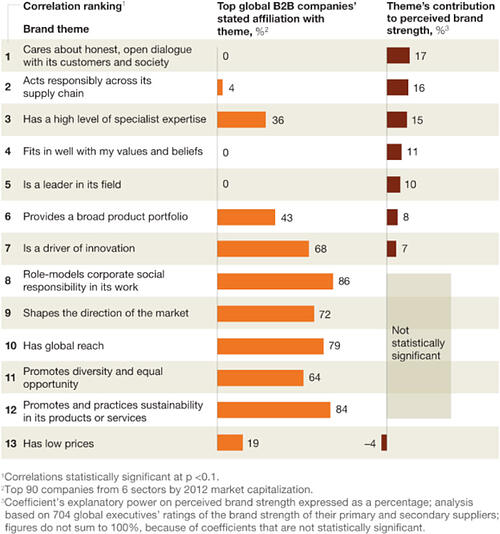Earlier this year, representatives from McKinsey and Company presented compelling information about the power of brands.
At a roundtable event, they explained how their report found a disconnect between the interests of B2B marketers and consumers.
The report examined public documents from 90 of the largest global companies to develop a list of brand positioning messages. These 13 themes range from topics like “low prices” to “promotes diversity.”
To get the other side of the story, McKinsey surveyed 700 global executives to see how important each theme was when evaluating brand strength.
The chart below shows how companies and consumers compare on different issues.

As you can see, B2B companies stress their corporate social responsibility and sustainability efforts, while buyers find those issues less than relevant.
Buyers found that the strongest brands have an open, honest dialogue with their customers and act responsibly across its supply chain.
B2B companies continuously miss opportunities to connect with their customers when they don’t talk about the issues that are most important to them.
In the United States, brand influences 18% of a consumer’s total purchase decision, making it vital to highlight what’s important to the customer. Many companies miss out on the emotional dimensions that affect a brand’s perceived strength.
How to ensure your brand’s message talks about things that really matter to your customers
Address pain points
Listen to your customer. Determine what their biggest pain points are and address how your offering fits in as a solution. If you truly understand your customer’s main concerns, you should be able to effectively communicate how you help solve the problem.
Be transparent
To think your customers don’t consider alternatives to your product is naive. Acknowledge that other companies have viable alternatives, but help your potential customer decide which is right for them.
For example, take a look at how a plastic tank manufacturer makes light of the fact that their products are incompatible with some chemicals on their website.
Cater to their emotions
McKinsey suggests using a combination of hard and soft facts to successfully reach your customers. It’s useful to show your customers the statistics behind your offering, but cater to their more emotional side as well.
The study indicates that B2B customers are interested an honest dialogue and a company’s values, so don’t be afraid to show a softer side.
Focus on value
Emphasize the benefit of your offering to your customers instead of filling your message with product features. B2B customers who see personal value (emotional, social, professional benefits) are 49% more likely to purchase a product and 60% more likely to pay a higher price.
The customer is interested in the value they will receive from choosing you, so clearly demonstrate this value by showing that you work hard to understand your customer’s needs and strive to meet them.
Talk to your customers, not around them
Instead of displaying your brand as “#1 in the industry” or “lowest prices around,” test your messages to make sure they’re effective.
Listen to your consumers and focus your message on the actual human that is interested in your offer. Reevaluate your message frequently to ensure you’re connecting with these consumers.
A brand message that is misaligned with the customer’s needs can have a negative effect on your perceived value.
Try to craft your message in a different way than your competitors – set yourself apart and constantly evaluate the way you’re connecting with customers.
McKinsey explains, "Consistently gathering information…and evolving in response are valuable ways of closing any gaps that may be opening up between your brand messaging and your customers’ needs."
Share & Prove You Found It First
The Digital Slate
Looking for timely digital marketing and sales insights to grow your business? Subscribe to our monthly digital newsletter for marketing professionals.
Subscribe


